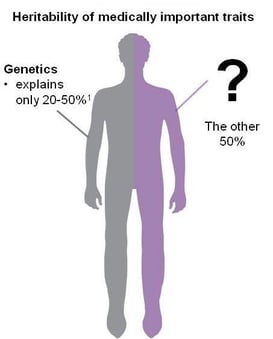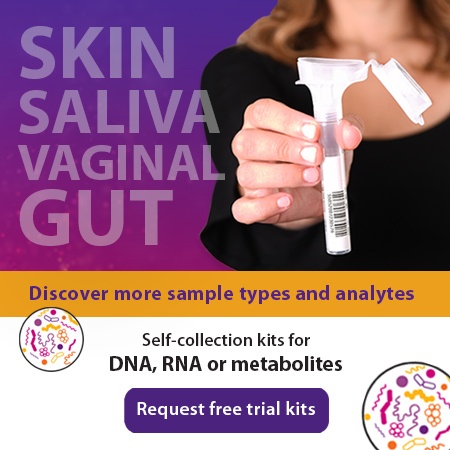2015-04-15
 So, you’ve just completed your latest human genomics research study and you’re waiting to hear if it has been accepted for publication. In the meantime, you’ve been exploring other hypotheses for health conditions and are interested in the growing field of microbiome and metagenomics research. According to a recent review, genetics explains ~20-50% of observed ‘heritability’ of medically important traits[i] but you’re interested in learning more about what makes up ‘the other 50%’. The dynamic microbiome is impacted by our daily activities and our environment (diet, exercise, sleep etc.) plays an important role in the etiology of chronic diseases not accounted for in GWAS. But there are a few items of interest that have delayed your decision to initiate a microbiome study. At the top of the list is how easy is it to integrate a microbiome study into your workflow? Is your lab set up to take on such a project? And what about the downstream applications and analysis. How different is it from SNP genotyping or whole genome sequencing? You also have to consider that you are used to working with saliva or blood and now you have to get familiar with a new sample type (and possibly an unpleasant one) – like feces. All these questions are getting into the ‘meat’ of things you consider when taking on your first microbiome project. But let’s back up a little and look at the big picture and find out why the microbiome is an interesting study area to pursue in the first place. Why all this fuss over some microbes?
So, you’ve just completed your latest human genomics research study and you’re waiting to hear if it has been accepted for publication. In the meantime, you’ve been exploring other hypotheses for health conditions and are interested in the growing field of microbiome and metagenomics research. According to a recent review, genetics explains ~20-50% of observed ‘heritability’ of medically important traits[i] but you’re interested in learning more about what makes up ‘the other 50%’. The dynamic microbiome is impacted by our daily activities and our environment (diet, exercise, sleep etc.) plays an important role in the etiology of chronic diseases not accounted for in GWAS. But there are a few items of interest that have delayed your decision to initiate a microbiome study. At the top of the list is how easy is it to integrate a microbiome study into your workflow? Is your lab set up to take on such a project? And what about the downstream applications and analysis. How different is it from SNP genotyping or whole genome sequencing? You also have to consider that you are used to working with saliva or blood and now you have to get familiar with a new sample type (and possibly an unpleasant one) – like feces. All these questions are getting into the ‘meat’ of things you consider when taking on your first microbiome project. But let’s back up a little and look at the big picture and find out why the microbiome is an interesting study area to pursue in the first place. Why all this fuss over some microbes?
 We know that the human microbiome is made up of bacteria, fungi and viruses that are unique to each individual and these microbes reside on us and in us.[ii] What is interesting is our microbial cells outnumber our human cells by roughly ten to one.[iii] These microbes, which make up a proportion of ‘the other 50%’, are associated with several different body sites being studied including oral, skin, vaginal, gut and nasal/lung. The gut contains the densest microbial community in the body and much research in the field centers around this area including inflammatory bowel disease, obesity, dietary changes and probiotic/prebiotic treatment. Today we’ll focus on the gut; however, there is wide applicability beyond GI disorders including inflammation, diabetes, c. Diff, autoimmune disorders, cancer, pregnancy, potential new drug targets for disease etc. A new focus on environmental factors is critical, with the microbiome being the most intimate environmental factor.
We know that the human microbiome is made up of bacteria, fungi and viruses that are unique to each individual and these microbes reside on us and in us.[ii] What is interesting is our microbial cells outnumber our human cells by roughly ten to one.[iii] These microbes, which make up a proportion of ‘the other 50%’, are associated with several different body sites being studied including oral, skin, vaginal, gut and nasal/lung. The gut contains the densest microbial community in the body and much research in the field centers around this area including inflammatory bowel disease, obesity, dietary changes and probiotic/prebiotic treatment. Today we’ll focus on the gut; however, there is wide applicability beyond GI disorders including inflammation, diabetes, c. Diff, autoimmune disorders, cancer, pregnancy, potential new drug targets for disease etc. A new focus on environmental factors is critical, with the microbiome being the most intimate environmental factor.
As you consider the microbiome for your next research project, you should think about how to integrate it from end-to-end in your workflow. Taking the time upfront in your project to ensure you have your whole pipeline planned out before you start will ensure your team is on the same page and will have a positive impact in terms of efficiency as your research gets started.
- First in the workflow is the pre-collection stage, which essentially refers to procurement, logistics and shipping. For example, how easy is it to collect samples from donors dispersed throughout various regions? At the pre-collection stage, you want a solution to maximize the quality of the sample collected, minimize handling and logistics, enable traceability and to eliminate cost and bulky packaging that occurs with cold chain.
- Second is the collection stage of the workflow where there are several considerations to take into account. Inexperienced participants need to be able to easily self-collect a sample. Ensuring your donors have clear instructions and an easy to use standardized device to collect the sample will minimize donor failure and help ensure a consistent, reliable sample. A device that liquefies the fecal sample has the benefit of making the sample easier to work with downstream and facilitates pipetting and processing. The other important aspect of the collection phase is ensuring your microbiome sample is stabilized at ambient temperature at the moment of collection so that the sample will be representative of the donor’s in vivo biology from collection through to result. If you are interested in the importance of stabilizing the microbiome sample please link to the following blog article “How critical is it to stabilize and standardize the microbiome profile?
- Next in the workflow is transport and storage which can be a critical step because it can be an expensive one if you don’t do your research. This is where the real benefit of working with a device that allows the sample to be transported and stored at ambient temperature comes into play. A device that allows for ambient temperature shipping, eliminates the bulky and costly packaging required for cold chain transport, enables scalability in your study and can greatly increase the value of your workflow if it can preserve the microbial profile under different environmental conditions.
- At the pre-analytical processing stage you want to ensure your collection device can easily and efficiently integrate into your lab. In the case of the microbiome, a fecal sample which is homogenized and maintains a consistent format eliminates processing steps in the lab such as dissection and weighing that is required with frozen stool samples. A standardized liquid sample simplifies workflows, increases processing efficiency and is ideal for automated systems.
- Last but not least is your results – you want to ensure you have quality results that are reliable. How do you do that? Look back at your workflow and ensure you are limiting the sources of variability for your samples. There are various sources of variability throughout a workflow including biological, environmental, DNA extraction, sequencing and analysis. In the microbiome space the largest source of variability can be attributed to sample collection and handling (environmental). Ensure that your device and collection instructions are simple for the inexperienced user and that the chemistry in your device has the ability to stabilize (or ‘snapshot’) the sample at the moment of collection and preserve it through to analysis. If a true representation of the in vivo biology is maintained throughout the workflow this will help ensure your results are reliable and reproducible.
We know it takes some planning when you enter into a new research area. The good news is we are here to support you in planning your microbiome study from end-to-end. Connect with your DNA Genotek microbiome specialist at info.dnagenotek.com to discuss your research plans and to find out about our microbiome services.
References:
[i] Zuk, OR. Hechter, Eliana. Sunyaev, Shamil R. Lander, Eric S. The mystery of missing heritability: Genetic interactions create phantom heritability. PNAS. January 24 2012. Vol. 109. no.4 1193-1198
[ii] http://www.actionbioscience.org/genomics/the_human_microbiome.html
[iii] http://www.drfranklipman.com/build-a-better-microbiome/


